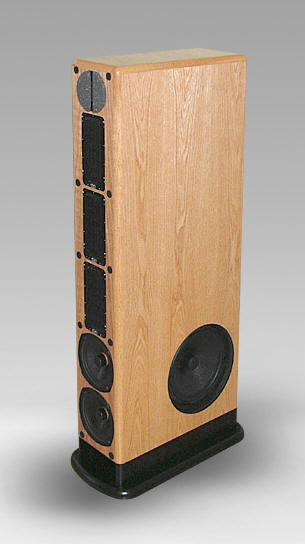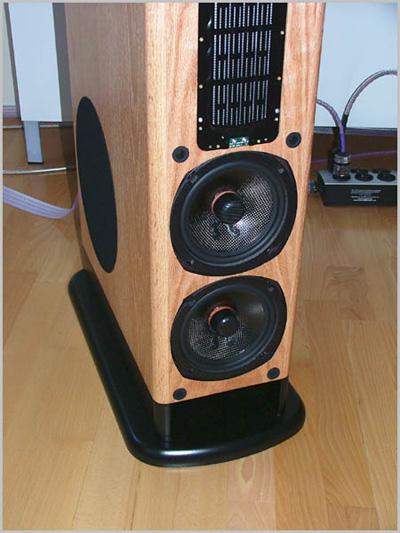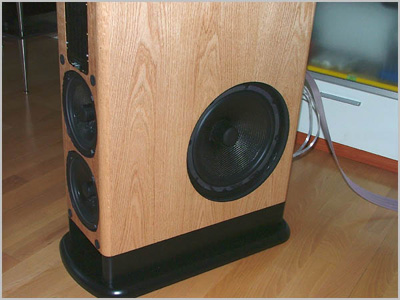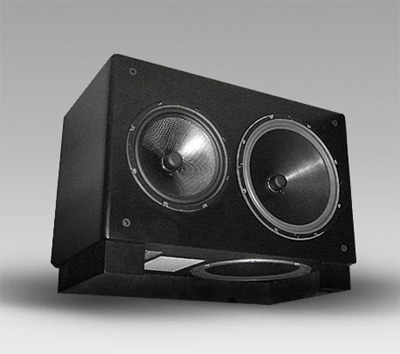You are reading the older HTML site
Positive Feedback ISSUE
16
november/december 2004
vmps
RM30 loudspeakers
as reviewed by Roger S. Gordon

All photographs are courtesy of VMPS Europe
|
ROGER S. GORDON'S SYSTEM
LOUDSPEAKERS
ELECTRONICS
SOURCES
CABLES
ACCESSORIES
|
Loudspeakers can be a problem. None are perfect. In fact, they are usually considered to be the most colored components in an audio system. In addition, auditioning speakers can be difficult. Have you ever asked a dealer if you could take his Dali Megalines home for an audition? For most of us, buying speakers involves more than just finding the best sounding ones in our price range. While we all have our own requirements, I'm sure that mine resemble those of many other audiophiles. The mandatory ones include:
1. They must fit my budget, without having to sell one or more of the children.
2. They must have a high probability of sounding good in my listening room, without my being able to do an in-home audition.
3. They must have an acceptably high Spouse Approval Factor, so that the chance of divorce is only slightly increased. Factors to consider in this respect include (1) size: small is good, large is bad, (2) placement: against the wall is good, one third of the way into the room is bad, (3) style: German speakers resembling space ships do not blend well with Colonial decor, and (4) color: the possibility of divorce increases the less that the finish of the speakers blends with the house furnishings.
Optional requirements include:
4. The bass should extend to the lowest octave. Music needs to be felt as well as heard.
5. With the significant other out of the house, the speakers should play LOUD (think Metallica at concert volume).
6. The speakers should be able to play soft. A lute sonata played at correct volume should sound like a lute.
7. The speakers should be musical. Do your toes tap? Do you play your air guitar or wave your air baton?
8. The speakers should be fairly easy to drive. A speaker with a sensitivity of 88-89dB and a 4-ohm load is about the most demanding that my deHavilland 845-G SET monoblocks amps can handle.
These requirements may seem simple, but they are somewhat contradictory. For example, deep bass from small speakers is not likely unless the laws of physics are repealed. Getting tight, thunderous, bottom-octave bass by driving inefficient speakers with 30-watt-per-channel SET amps is also against the laws of nature. However, there are thousands of loudspeakers on the market, so there must be one or two that fit my requirements. Fortunately, by virtue of attending CES and other high-end trade shows, I get to hear many speakers, and I hear them in non-ideal rooms. If a speaker can sound good in a hotel room, it has a chance of sounding very good in my listening room. A few years ago, I realized that it was time to replace my VMPS FF-3s. As much as I loved them, what I heard at trade shows told me that speaker designs had surpassed the state of the art of the mid 90s, when the FF-3s were created. I kept my speaker requirements in the back of my mind as I attended the shows, along with a short list of the speakers that might fit the bill. I heard the VMPS RM40s at CES 2002, the year that they won the Best of CES award. Could these be my new speakers? They met my requirements. They were about the same size as my FF-3s (66 inches tall), so the Spouse Acceptance Factor was no worse. Like the FF-3s, they could be pushed close to the wall. They were only slightly harder to drive than the FF-3s. Hmmmm.
During the next year, I listened to the RM40s several times, in different systems. They always sounded great, but something was holding me back. At CES 2003, VMPS demoed their new flagship speakers, the RM/Xs. Bigger, badder, and louder, they sounded even better than the RM40s, due to their new ribbon supertweeters. However, they were definitely out of my league because of their larger price and size. I decided to shelve the idea of buying new speakers. In late 2003, VMPS announced that for CES 2004, they would be demoing the RM30s, new speakers based on the RM/X technology but much smaller than the RM40s.

When I first saw the RM30s, I found them to be visually striking—four feet tall, eight inches wide, twenty inches deep, and weighing only 110 pounds, which meant they had a very high Spouse Acceptance Factor. Into each reasonably sized box was packed the ribbon supertweeter from the RM/X, three of VMPS' proprietary neodymium planar-ribbon midrange panels from the RM/X and RM40, a 10-inch side-firing woofer, two 6-inch front-firing woofers, and two 6-inch downward-firing slot and mass-loaded passive radiators. Because of the small cabinet, the RM30s' 3dB rolloff point was 37 Hz. The laws of physics cannot be circumvented, but the RM30s were VMPS' answer for people who want a home theater system with high-end sound. The RM30s come in two versions, the RM30M, already described, and the RM30C, which omits the side-firing woofers and is intended to be used as a center channel. Since home theater needs a subwoofer, VMPS was also showing their new Model 215 subwoofer, which employs two 15-inch drivers, one front-firing active driver and one downward-firing slot and mass loaded passive radiator. The subwoofer rolls off at 55 Hz with a 6dB slope. The RM30Ms, augmented by the 215 sub, extend to the low 20s.
I visited the VMPS room numerous times, and listened extensively to the RM30M/215 combination. The sound was very similar to what I had heard in that room with the RM40s in 2002 and the RM/Xs in 2003, except that there was a little more detail and a little more clarity in the upper midrange and treble. This was due to the narrower cabinet. Less width means less diffraction and better sound, and in fact, the $3499 RM30Ms sounded better than either the $4999 RM40s or the $11,900 RM/Xs in the same room with the same electronics. They were giant killers.
After the show, I placed my order for a pair of RM30Ms with a VMPS Larger Subwoofer ($839) rather than the 215. The Larger sub comes with two active woofers (12-inch and 15-inch) and a 15-inch downward-firing, slot-loaded passive radiator, which gives it a 3dB rolloff point of 17Hz that will rattle your pant legs. I ordered the sub with no crossover, but with dual voice coils and the megawoofer drivers. The RM30s at CES were prototypes. My pair came from the first production run. I ordered the Auricap capacitor upgrade ($550), since that gave most of the sonic improvement of the TNT dynacap capacitor upgrade ($1200) for much less money. These were the only options available at the time. You can now order a set of four 6-inch megawoofers ($380) that will allow the RM30Ms to play louder and lower (32Hz). For $400 you can also upgrade the wiring to Analysis Plus.
The setup of the RM30s was very simple. There is a big difference between shoving these 110-pound speakers across the carpet and moving the 300-pound FF-3s. Due to the close family resemblance of all VMPS speakers, the best-sounding position for the RM30Ms was where the FF-3s had stood—eighteen inches out from the wall, eight feet apart, toed in (per the VMPS manual) so that the sound waves crossed three feet in front of my listening position. I put the sub against the wall between the speakers, shifted over toward the left speaker so that I could fit the amps between the speakers to the right.

One of the things that I had worried about while awaiting the arrival of the RM30Ms was how to blend them with the subwoofer. I had experimented with mini-monitors and subwoofers in the 80s, and had been frustrated by the audibility of the external crossovers and the fact that I could always aurally locate the sub. Would I have the same problems again? As it turned out, the RM30Ms and the Larger are a marriage made in heaven. After a few trials and errors, I settled on the following setup. My Herron preamp has two sets of main outputs. One set goes to the deHavilland amps, which can drive the RM30Ms as loud as I can stand without clipping and without having to roll off the bass with an external crossover. Hurrah! The other set of preamp outputs goes to an electronic crossover with a continuously variable crossover point and a volume control. From the crossover, the signal goes to a pair of Electron-Kinetics (John Iverson) Eagle 400 monoblock solid state amps that I picked up used for $700. Using my trusty Radio Shack Sound Pressure Meter, then fine-tuning by ear, I settled on a 60Hz hinge point. Because of the low hinge point (most people can't locate bass sources when the frequency is below 80Hz) and fast crossover slope, I cannot aurally locate the subwoofer, nor can any of my audiophile friends who have heard the system. Double Hurrah!
Once the speakers were broken in (about 100 hours), it was time to fine-tune the setup. One of the nice things about VMPS speakers is that the customer can tune the speakers to correct for room problems and/or suit their individual preferences. The mass-loaded passive radiators come from the factory weighted with mortite (rope putty). By adding or taking away mortite, you can change the Q of the bass. Knowing that most people don't have extra mortite lying around the house, VMPS deliberately adds too much mortite, so you only need to take it away. By reaching into the slot at the base of each speaker, you remove little bits of the material, smaller than a BB. As you remove mortite, you gradually hear additional clarity in the lower midrange and tighter bass. Each removal should improve the sound until the midrange starts to sound a little muddy, at which point you have gone too far. How much mortite you need to remove depends upon your room and each speaker's location within it. If you move the speakers, you will need to retune.
With the bass tuned, it was time to tune the midrange and treble. On the back of each speaker are two L-pads that control the volume of the treble and the midrange. If your room is too bright, you can back off the treble. If you room is asymmetrical and the midrange is out of balance, you can change the volume of one speaker to compensate. Virtually all of us have less than ideal listening rooms. It is nice to have speakers that are designed to at least partially compensate for room problems.
After all of this, how do the RM30Ms sound? I have been listening to them for almost eight months, and I am still amazed at what fantastic analytical tools they are. Any change I make to upstream components is readily apparent. Interconnects, power cords, CD treatments, even record cleaning solutions—every change is clearly audible. I suspect that the ribbon supertweeters and ribbon midrange are the reason. Ribbons don't store significant amounts of energy, like cone drivers, and they can start and stop on a dime. The leading transients of instruments like bells and triangles are crisp and clean.
Okay, the RM30Ms are useful as analytical tools. Big deal—so is an oscilloscope. Can they play music? Do they make you want to tap your toes, stomp your feet, and play your air guitar? At the end of a song, do you jump up out of your seat, wave your fist in the air, and shout "Yeah!"? The answer is yes. The RM30Ms play music, and the reason is in the midrange. Music is in the midrange. Listen to a 78 rpm record. There is no bass, there is no treble, yet even without them, a 78 can be exceedingly musical. The RM30Ms have two crossover points, 166Hz and 7kHz. There is no crossover in the critical midrange. In the critical band between 200Hz and 6kHz, where the music lies, there is nothing to screw up the sound or introduce subtle phase shifts. The best crossover is no crossover. I suspect this is why I enjoy listening to the very affordable, crossover-less Omega loudspeakers at trade shows.
Aside from a midrange to die for, the RM30Ms have a very good treble. The ribbon supertweeter is clean and clear, with no ringing like you get with some dome tweeters. The only negative is that it is beamy. Two people sitting side by side, ten feet back from the speakers, can enjoy the sweet spot, but if you stand up, you lose the highs. The RM/X tries to solve this problem by having the supertweeter on a swivel that can be aimed directly at the sweet spot, but this doesn't really work. The only solution is to sit further away from the speakers, so that the beam has more room to expand. This is not practical in most rooms. I have not found the RM30Ms' beaminess to be a problem. Their sweet spot is much larger than that of other high-end speakers that I have heard, and I am seated when I do my critical listening.
VMPS is known for exceptional bass quality. The only complaints I have heard about VMPS bass is that there is too much of it, and I find those complaints hard to fathom. Based upon comparison with live music, I find the quantity of VMPS bass to be just about right, and I find many other popular speakers bass shy. Different strokes for different folks. The bass generated by the RM30Ms is tight, tuneful, and forceful. If you like the Big Drum on Telarc recordings, you will love it on the RM30Ms. It is not just a boom. You can hear the initial stroke, the tone and timbre of the drum, then the decay. Lovely. Many people will feel no need to add a subwoofer. After all, the lowest instrument in the orchestra, the double bass, only goes down to 37Hz, the 3dB downpoint of the RM30Ms. However, if you love organ music, soundtracks, or heavy metal, you will need a subwoofer, or the RM40s. With a sub, the RM30Ms will play any music that you throw at them. Crank up the volume and feel the music. Metallica never sounded sooooo good.

Have the RM30Ms met the requirements that I established for myself over two years ago? Let's see.
1. Price: The RM30Ms plus Larger Subwoofer with upgrades, used crossover, used solid state amps, and used cabling, came to slightly over $6000—at the upper limits of my budget, but doable.
2. Sound: They sound as good in my home as they did at trade shows and dealer showrooms. With the ability to tune the RM30Ms to my room, I think they sound at least as good as the RM40s that won the Best of CES 2002.
3. Spouse Acceptance Factor: Even with the addition of the subwoofer, the RM30Ms have less of a visual impact than the FF-3s. SAF is much higher.
4. Bass: Thunderous, tuneful bass down to 17Hz. Not many $6000 high end speaker systems can offer that.
5. Ability to play loud: In my medium-sized room, the system will play loud enough to drive my wife out of the house, and louder than I can stand.
6. Ability to play soft: If, late at night, with the lights out, I play Kapsberger, Pieces for Lute (Harmonia Mundi HM 59), it sounds like Paul O'Dette is right in the room with me.
7. Musicality: My system plays music. Virtually everything I play—rock, classical, jazz, vocal, soundtracks, or acoustic guitar—sounds like music. I have a hard time shutting the system down at night. I just want to hear more music.
8. Ease of use: The RM30Ms come set up for bi-wiring, with one set of binding posts for the bass and one for the midrange/treble. The bass section is 91dB/4 ohms and the midrange/treble 93dB/8 ohms. These are easy speakers to drive.
The RM30Ms plus the Larger subwoofer have met all of my requirements, and I am one happy camper. Are the RM30Ms the perfect speaker? Hardly. I don't think there is any such thing. I have heard speakers at trade shows that I think are better than the RM30Ms plus subwoofer, but they all cost megabucks. At a price near $6000, I have not heard any that are competitive, except the VMPS RM40s, which I also think are an incredible bargain.
Should you buy a pair of RM30Ms? Maybe. There are drawbacks. They cannot play as loud or fill as large a room with sound as their bigger brothers, the RM40s and RM/Xs. Nor can the RM30Ms, by themselves, go as low. In some things, size really does matter. However, if you have a small to medium-size room and don't need sound pressure levels that will make your ears bleed, the RM30Ms with subwoofer are sonically superior to the RM40s and RM/Xs. I love the RM30Ms, if you hadn't already guessed.
Footnote: www.vmpsaudio.com is the official VMPS website. It is horribly out of date, though an extensive update has been promised. If you want current information, try www.vmpseurope.com or the VMPS portion of the audio manufacturers section of www.audiocircle.com, where official price lists, pictures, and other useful information are posted. The Audio Circle forum also contains lots of information about the equipment that VMPS owners use with their speakers. There is helpful setup information for both two channel and multi-channel. The forum also contains official and unofficial tweaks, if that is your persuasion. Some of the user tweaks have been incorporated into current production. The site also has a list of VMPS owners willing to have you come to their home to hear their speakers. Roger S. Gordon
RM30 loudspeakers
Retail: $3499 pair
VMPS Audio Products
3429 Morningside Dr.
El Sobrante, CA 94803
TEL: 510. 222. 4276
email address: [email protected]
web address: www.vmpsaudio.com
